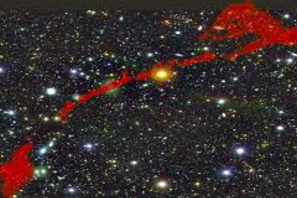Astronomers have recently made discovery in the field of astrophysics and used the MeerKAT radio telescope to study giant radio galaxies in the COSMOS field. A new giant radio galaxy was identified, expanding our understanding of these cosmic phenomena. This finding was published on November 11 in a research paper on arXiv.
What are Giant Radio Galaxies?
Giant radio galaxies (GRGs) emit radio waves across vast distances, which typically extend over 2.3 million light years. GRGs are rare and often found in low-density regions of space. Their structure includes jets and lobes composed of plasma. GRGs help scientists learn about radio source formation and evolution.
The MeerKAT Radio Telescope
The MeerKAT telescope is located in South Africa and is particularly effective for studying GRGs at high frequencies, around 1.0 GHz. The telescope’s capabilities enhance the analysis of these galaxies. It is part of the MeerKAT International GHz Tiered Extragalactic Exploration (MIGHTEE) survey.
Kathleen Charlton and her team conducted the research. They created detailed maps of three GRGs using data from MeerKAT’s UHF band and MIGHTEE L-band. One of these galaxies was previously unknown. It was designated as MGTC J100022.85+031520.4.
The MeerKAT telescope is located in South Africa and is particularly effective for studying GRGs at high frequencies, around 1.0 GHz. The telescope’s capabilities enhance the analysis of these galaxies. It is part of the MeerKAT International GHz Tiered Extragalactic Exploration (MIGHTEE) survey.
Kathleen Charlton and her team conducted the research. They created detailed maps of three GRGs using data from MeerKAT’s UHF band and MIGHTEE L-band. One of these galaxies was previously unknown. It was designated as MGTC J100022.85+031520.4.
Characteristics of the New GRG
The new GRG is hosted by an elliptical galaxy, SDSS J100022.85+031520. This galaxy is about 1.1 billion light years away. Its size measures approximately 4.2 million light years. It has a mass 93 trillion times that of the Sun. The power output is 597 ZW/Hz at 1,284 MHz. The galaxy is estimated to be one billion years old.
MGTC J100022.85+031520.4 is the central galaxy in the cluster WHL J100022.9+031521. Its position and the bent shape of its top lobe suggest features similar to wide-angle-tail (WAT) radio sources. WATs are typically found in clusters where gas pressure influences their structure. This discovery contributes to the understanding of GRGs in cluster environments.
Website: International Research Awards on Civil and Environmental Engineering.
Visit: civil.scifat.com
NominateNow:https://civil-engineering-conferences.scifat.com/award-nomination/?ecategory=Awards&rcategory=Awardee
Twitter: x.com/LilyS2727
Facebook: facebook.com/civilengineeringaward/
YouTube: @EnvironmentalEngineering24
#GiantRadioGalaxy
#GRGDiscovery
#NewGRG
#AstronomyNews
#RadioAstronomy
#CosmicDiscovery
#AstronomyBreakthrough
#SpaceExploration
#GalacticDiscovery
#RadioWaves
MGTC J100022.85+031520.4 is the central galaxy in the cluster WHL J100022.9+031521. Its position and the bent shape of its top lobe suggest features similar to wide-angle-tail (WAT) radio sources. WATs are typically found in clusters where gas pressure influences their structure. This discovery contributes to the understanding of GRGs in cluster environments.
Website: International Research Awards on Civil and Environmental Engineering.
Visit: civil.scifat.com
NominateNow:https://civil-engineering-conferences.scifat.com/award-nomination/?ecategory=Awards&rcategory=Awardee
Twitter: x.com/LilyS2727
Facebook: facebook.com/civilengineeringaward/
YouTube: @EnvironmentalEngineering24
#GiantRadioGalaxy
#GRGDiscovery
#NewGRG
#AstronomyNews
#RadioAstronomy
#CosmicDiscovery
#AstronomyBreakthrough
#SpaceExploration
#GalacticDiscovery
#RadioWaves





No comments:
Post a Comment